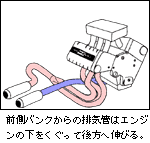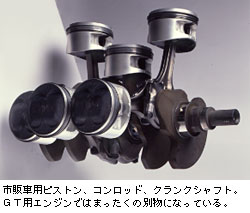This is an english translation of an original japanese article by Honda of Japan. The rights to this english translation belong to the Temple of VTEC Asia. All contents of this article are the intellectual property of Honda of Japan. Please refer to the main index page for further details.

Learn of the Secrets Unseen From the Grandstands
Volume 3 - Refined Power Behind its Back
Lecturer: Makoto Nagaosa
According to the All-Japan GT Championship rules, the basic design of the engine cannot be altered. As a result, this becomes a different challenge from creating a Formula 1 engine from scratch. I will talk about the design challenges this time.
*A Lower Engine Position is Desirable
| When developing the GT version NSX, the V6 engine had to be installed sideways. As you know, the exhaust piping for a V6 is to its sides. When such an engine is installed in a vehicle sideways, the exhaust piping from one side will have to wrap around from the front. Placing this piping in an appropriate place can be a big headache. |  |
|
The front-facing half's piping goes under the engine. |
The factory NSX takes this piping and puts it below the engine and towards the rear. There isn't any space to the side of the engine, and putting it above the engine would make maintenance extremely difficult. The same condition applies to the GT version NSX. However, when one considers the GT version NSX, we are quickly reminded that this is not acceptable. As a race car, the heavy engine must seek out a low as possible position in the chassis.
 |
 |
|
The lower the better - | |
The lower the engine is, the tighter the space below the engine. In other words, there will no longer be any room for the exhaust piping. At the same time, the engine cannot be positioned to too high a location -- handling and overall performance will suffer. Such a dilemma would not exist if we were allowed to mount the engine facing forward -- however, those are the GT championship rules, and that is what we must abide by. (No solution? I guess it's classified... - editor)
*Even Air Delivery to All 6 Cylinders
As can be seen from the picture to the right, there is an airbox above the engine. This airbox has some modifications performed to it. The NSX uses a V6, where 6 cylinders all take in a mixture of air and fuel, combust, and produce power. As the pursuit for race-quality, optimized power continues, the balance of performance between the cylinders becomes a real issue. Without an even delivery of air, the overall balance of the engine will not be maintained, and performance will suffer.
|

|
|
Complete engine view - the airbox |

|
However, we reach yet another problem. The NSX's engine is mounted facing sideways. To the left of the engine is the transmission, and as a result, the engine will be mounted slightly off-center. In comparison, the airbox is mounted in the center of the vehicle. The incoming air will need to make a turn as it enters the 6 cylinders, causing for slight variations in air flow. It may seem like a minute detail, but to extract maximum performance under grueling conditions from a factory engine requires everything to be perfect, or close to it. To deliver air evenly to 6 cylinders located in different places was a daunting task. While it does not stand out, the airbox and its modifications are an extremely important aspect of the GT version NSX. |
| The secret airbox allows airflow to be distributed evenly despite the odd air pathway. |
*To Turbo or Not to Turbo
The All-Japan GT Championship regulations allow for the manufacturer to use any engine available in their lineup, and with or without a turbocharger. Naturally, both of these topics were heavily debated.
As you know, we ended up using the factory-equipped V6 engine in its NA form. This is because we felt that the this would be in-line with the spirit of the GT Championships. After all, the challenge is to take a factory car, and extract as much performance as one can -- and in order to do so, we felt that it was important that we keep the basic configuration of the NSX's engine the same.
 |
Indeed, the option of turbocharging the vehicle seemed very lucrative. Matter of fact, all of the NSX's rivals use a turbocharger to extract more power. However, in race form, a larger-than-normal turbocharger is used -- causing the vehicle to experience lack of performance when the turbo is at low boost, and a surge of power when the turbo is at high boost. In comparison, a NA engine will output as much power as the force applied to the accelerator -- making it easier to control for the driver. We felt that in order for the NSX's wonderful footwork to live up to its full potential, a NA engine was the right match. |
| Factory piston, connecting rod, crankshaft They are all replaced with the GT version |
Under the regulations, basic engine components such as the cylinder head and cylinder block cannot be modified. However, the innards such as the camshaft, valves, pistons, connecting rods, crankshafts, etc.. were all replaced. In the picture above, you can see the factory parts -- we regret that we cannot show you the race version, as it would disclose too many secrets.
| INDEX | ||
| NEXT |
Updated December 15, 1999